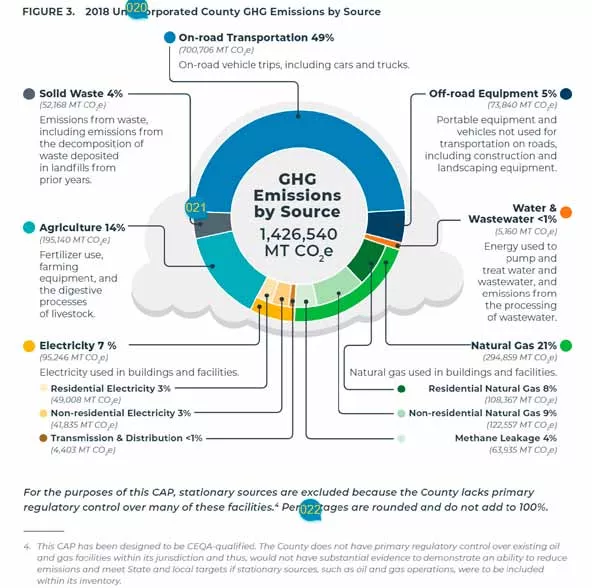By Katie Davis
Dirty loophole
It’s time for Santa Barbara County to close the special loophole for the oil and gas industry that excludes this one industry’s emissions from the County’s inventory of greenhouse gas emissions.
The County has been working on their 2030 Climate Action Plan for years, which is up for approval by the Board of Supervisors this summer. The goal is to reduce greenhouse gas emissions 50% by 2030 (below 2018 levels), in line with what the global community agrees is necessary to avoid the worst impacts of climate change.
The problem lies in how the County is counting emissions and measuring our success at reaching the goal. To put it simply, they are cheating by leaving out emissions from the oil industry.

That makes the exercise both untrue and unfair. It’s untrue because a greenhouse gas inventory should be a neutral tally of all community emissions so that we can accurately see how we’re doing over time. And it’s unfair because all the rest of us are challenged to reduce our emissions, while the oil industry—the industry most responsible for getting us into this climate mess—is left off the hook.
Nor is this a minor omission. If these oil and gas facilities, referred to as “stationary source emissions,” were included, they will make up about 13% of County emissions in 2018. After transportation, oil and gas facilities are one of the largest polluters in the County. They’re responsible for more emissions than all our electricity use, in line with agriculture emissions, or all the natural gas we burn in buildings.
If Exxon’s facilities, shut down since the 2015 Refugio oil spill but once one of our largest polluters, were turned back on, stationary source emissions could be 30% or more of total emissions. If we reduce other pollution sources, the oil industry could become the largest source of pollution in the County.
The oil industry doesn’t want their emissions counted or to have to figure out how to reduce them because they know that the remaining oil in the County is tar-like and difficult to extract. It takes polluting, energy-intensive methods to produce oil here. Steam generators burn gas in order to melt the oil out of the ground at high heat.
Rather than confront this reality, the County is papering it over.
The rationale given by the County for excluding oil and gas facility emissions is that “the County lacks primary regulatory control over many of these facilities.” The problem with that argument is that the County doesn’t have “primary regulatory control” over any of the other sectors either.
If anything, the County has more control over emissions from the oil industry through its permitting authority than other sources like agriculture or what kind of cars we all choose to drive and how much we drive. If the inventory was restricted to “primary regulatory Control,” there would be virtually nothing to count at all.
In fact, County actions have made a difference. Oil industry emissions are half what they were in 2008, in part due to County actions. It is within our ability to continue that positive momentum. Doing so would lower not only carbon emissions, but other air pollutants that cause asthma, cancer and other health impacts as well.
Stark contrast
In stark contrast to Santa Barbara County, other counties, such as Ventura and Los Angeles, do count oil industry emissions, and they are taking action to reduce those emissions. Los Angeles is working towards phasing out oil and gas, and Ventura County requires the use of “electrically powered equipment from 100 percent renewable sources and cogeneration” for oil and gas exploration and production and prohibits venting and flaring of natural gas to lower emissions. Ventura’s regulations were weakened by the oil industry but still represent progress.
California and Santa Barbara County in particular, has experienced record-breaking wildfires, flooding, and drought made worse by climate change. Our beaches are vulnerable to sea level rise and our agriculture and tourism economy by extreme weather. We’re losing insurance companies willing to cover the escalating risks. The costs of climate inaction will soar.
Whether we take climate action seriously or not matters. If California was a nation, it would be the 5th largest economy in the world. With the largest population and economy of any U.S. state, California’s goals and policies directly influence the nation and the world.
One thing California can do is ask local jurisdictions to figure out how to reduce emissions in their regions, but that only works if we are transparent and honest about where carbon emissions are generated, and don’t give the most polluting industries a free pass.
According to the global scientific consensus, the next few years are critical. Santa Barbara should be leading the world in a transition to clean energy and climate action—not cheating on our 2030 Climate Plan.
Ask our Board of Supervisors to count all emissions, including those from the fossil-fuel industry in the 2030 Climate Action Plan. You can email them at:
sbcob@countyofsb.org
cap-sign-on-letter-2024-final.pdf882.61 KB santa-barbarba-ventura-chapter-cap-letter-8.21.24.pdf281.69 KB